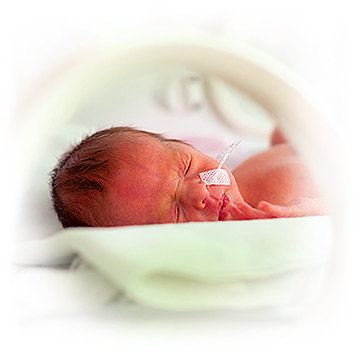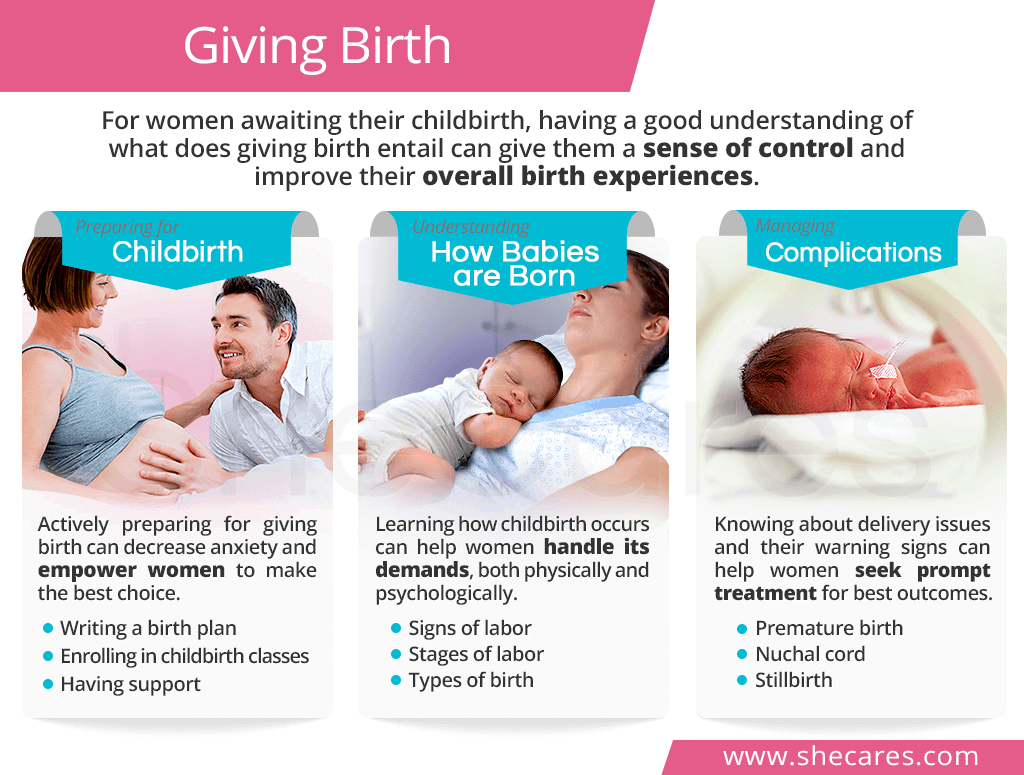Preparing for Childbirth

Just like any other major life event, childbirth calls for thorough preparation to feel empowered to make the best choices for oneself and one's baby. Preparing for giving birth can consist of the following steps:
Writing a Birth Plan
A birth plan is a personalized list of the care a woman wants to receive during labor and delivery as well as afterwards. Writing a birth plan allows a woman to feel more in control over of the upcoming childbirth and appease any doubts that might arise. Women can download a birth plan template or create their own version.
Enrolling in Childbirth Classes
Nowadays, there are a variety of childbirth preparation classes, where an expectant mother can learn techniques designed to make giving birth to a baby easier and less painful. The most popular ones include the following:
- Lamaze method
- Bradley method
- Alexander technique
Having Support during Childbirth
Having support during childbirth is key for healthy pregnancy outcomes. Women who had a childbirth companion were found to have shorter labors on average, better managed pain, and required less medical interventions.1, 2
- Partner
- Family and friends
- Doulas
Continue reading more to find out how to prepare for childbirth or move to the next section to get a closer look at how are babies born.
How to Deliver a Baby

Giving birth to a baby is an enormous undertaking for all women, both physically and psychologically, a good understanding of which can help expectant mothers ease the anxiety and better prepare to handle its demands.
Signs of Labor
While women may notice various body clues that birth is imminent, such as lightening, bloody show, or mucus plug, it might be days or weeks before they actually go into labor. Most common signs of true labor include the following:
- Contractions that are regular and grow stronger and closer together
- Spontaneous rupture of membranes, commonly called one's water breaking
- Dilation and thinning of the cervix
Stages of Labor
There are three stages of labor, each with distinct characteristics and duration, including the following:3
The first stage of labor begins with the onset of labor and lasts until the cervix is fully dilated (reaches 10 centimeters). The first stage can take 12 to 19 hours and is further divided into three sub-stages, namely latent, active, and transition.
The second stage of labor consists of delivering the baby, which can take 20 minutes to 2 hours.
The third stage of labor is the delivery of the placenta, which can happen within minutes after delivering the baby or up to 30 minutes.
Types of Birth
Expectant mothers can undergo one of two types of birth:
Vaginal birth is the most common type of birth with 68% of all babies born that way.4 Many women who have had a C-section in the past can now have a safe vaginal birth after C-section (VBAC).
Cesarean section, consisting of taking the baby out through the mother's abdomen, occurs in 32% of all pregnancies.4
Women can choose from a number of options to manage birth pain, such as opioids or an epidural. Some will choose to undergo natural childbirth, which is birth without pain medications. Others explore various birthing positions to cope with the pain, like squatting or using a birthing ball.
Alternative Birth Methods
In the recent years, various alternative birthing methods have risen in popularity. There are generally an option only for healthy women in low-risk pregnancies and should first be approved by an overseeing obstetrician.
- Home birth with the help of a midwife
- Water birth can take place at home or a birthing center
Keep reading to learn more information on how to deliver a baby or continue to the next section to learn more about dealing with possible birth complications.
Childbirth Complications

Childbirth complications can arise at any time, both in a healthy mother giving birth as well as one with known risk factors. Luckily, when detected early on, most of them can be effectively treated to improve childbirth outcomes.
Premature Rupture of the Membranes
Premature rupture of the membranes (PROM) is when the water breaking occurs before labor begins. If it happens near the due date, and labor does not begin within 24 hours, an induced labor can prevent infections. If waters break before the 34th week of pregnancy, close monitoring at the hospital will be required.5
Premature Birth
Premature birth, or preterm birth, is defined as birth that occurs before the 37th week.6 The earlier the delivery, the more detrimental the effect it has on the baby and his or her well-being.
Post-term Pregnancy
Post-term pregnancy is defined as pregnancy that extends past 42 weeks.7 Depending on the mother and baby's health, labor can be induced to allow vaginal delivery, or a C-section will be performed to prevent further complications.
Preeclampsia
Preeclampsia occurs when a woman develops high blood pressure and protein in urine in late pregnancy. While the only effective advanced preeclampsia treatment is delivering the baby, its mild form can be managed to delay delivery.
Nuchal Cord
Nuchal cord is a situation when the umbilical cord is wrapped around the baby's neck. While most babies with nuchal cord can be born naturally in a safe way, some will require a C-section delivery to prevent further distress.
Stillbirth
Stillbirth is defined as fetal death that occurs after the 20th week, including during delivery.8 While about half of all cases do not have a clear cause, a post-term pregnancy and preeclampsia are some of the main risk factors.
Keep on reading for a broader understanding of the specifics on childbirth complications.
Conclusions
As one of the most important events in a woman's life, the anticipation of labor and delivery can naturally cause a great deal of emotional distress. Luckily, expectant mothers can embrace the upcoming experiences by educating themselves about what giving birth to a baby entails. Now when holding one's newborn is just moments away, it is more important than ever to take the time to prepare by writing a birth plan, attending classes, or finding reliable support as well as understanding how babies come to this world and what options a women has to have a say in giving birth to her baby. With adequate preparation and knowledge comes a sense of control in the process, which can translate into a more peaceful and more beautiful childbirth.
Sources
- American Pregnancy Association. (2019). Creating Your Birth Plan. Retrieved September 26, 2019 from https://americanpregnancy.org/labor-and-birth/birth-plan/
- American Pregnancy Association. (2019). Having a Doula: Their Benefits and Purpose. Retrieved September 30, 2019 from https://americanpregnancy.org/labor-and-birth/having-a-doula/
- American Pregnancy Association. (2019). Home Birth. Retrieved September 30, 2019 from https://americanpregnancy.org/labor-and-birth/home-birth/
- American Pregnancy Association. (2015). VBAC: Vaginal Birth After Cesarean. Retrieved September 30, 2019 from https://americanpregnancy.org/labor-and-birth/vbac/
- Better Health Channel. (2018). Alexander technique. Retrieved September 26, 2019 from https://www.betterhealth.vic.gov.au/health/conditionsandtreatments/alexander-technique
- Better Health Channel. (2017). Pregnancy - labour. Retrieved September 30, 2019 from https://www.betterhealth.vic.gov.au/health/healthyliving/pregnancy-labour
- Cleveland Clinic. (2016). Labor & Delivery. Retrieved September 26, 2019 from https://my.clevelandclinic.org/health/articles/9676-labor--delivery
- Lamaze International. (2019). Get to Know Lamaze. Retrieved September 26, 2019 from https://www.lamaze.org/myths-about-lamaze
- Medline Plus. (2019). Childbirth. Retrieved September 30, 2019 from https://medlineplus.gov/childbirth.html
- NHS. (2018). How to make a birth plan. Retrieved September 26, 2019 from https://www.nhs.uk/conditions/pregnancy-and-baby/how-to-make-birth-plan/
- Pregnancy, Birth & Baby. (2018). Making a birth plan. Retrieved September 26, 2019 from https://www.pregnancybirthbaby.org.au/making-a-birth-plan
- The Journal of Perinatal Education. (2011). Lamaze Breathing. Retrieved September 26, 2019 from https://www.ncbi.nlm.nih.gov/pmc/articles/PMC3209750/
Footnotes:
- The Journal of Perinatal Education. (2013). Impact of Doulas on Healthy Birth Outcomes. Retrieved September 30, 2019 from https://www.ncbi.nlm.nih.gov/pmc/articles/PMC3647727/
- Office on Women's Health. (2018). Labor and birth. Retrieved September 26, 2019 from https://www.womenshealth.gov/pregnancy/childbirth-and-beyond/labor-and-birth
- CDC. (2017). Births - Method of Delivery. Retrieved September 26, 2019 from https://www.cdc.gov/nchs/fastats/delivery.htm
- Eunice Kennedy Shriver National Institute of Child Health and Human Development. (2017). What are some common complications during labor and delivery? Retrieved September 30, 2019 from https://www.nichd.nih.gov/health/topics/labor-delivery/topicinfo/complications
- Facts, Views & Vision. (2012). Postterm pregnancy. Retrieved September 30, 2019 from https://www.ncbi.nlm.nih.gov/pmc/articles/PMC3991404/
- Medline. (2019). Premature infant. Retrieved September 30, 2019 from https://medlineplus.gov/ency/article/001562.htm
- WHO. (2013). Counselling for Maternal and Newborn Health Care. Retrieved September 30, 2019 from https://www.ncbi.nlm.nih.gov/books/NBK304186/
- CDC. (2019). Stillbirth. Retrieved September 30, 2019 from https://www.cdc.gov/ncbddd/stillbirth/facts.html
